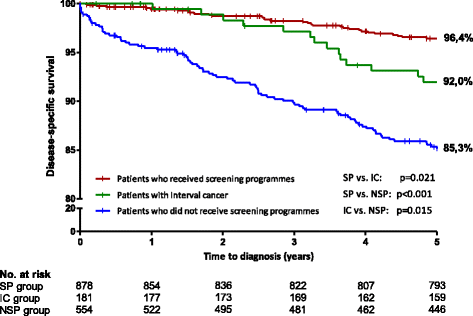Aggressive primary treatments with favourable 5-year survival for screen-interval breast cancers
- PMID: 29625602
- PMCID: PMC5889614
- DOI: 10.1186/s12885-018-4319-4
Aggressive primary treatments with favourable 5-year survival for screen-interval breast cancers
Abstract
Background: To assess the impact of the participation in screening programme according to the mode of detection on the early diagnosis, treatment, and specific survival outcomes in women with breast cancer.
Methods: Women diagnosed with invasive breast cancer in Poitou-Charentes region (France) between 2008 and 2009 were classified into three groups, using data linkage of cancer registry, vital statistics and French organized screening programme: the screening programme (SP), interval cancer (IC), and non-screening programme detected cancer (NSP) groups. Specific survival rates were analysed using the Kaplan-Meier method and Cox proportional hazard models.
Results: Among 1613 patients, 65.7% (n = 1059) participated in a screening programme. The interval cancer rate was 17.1% (n = 181). Tumours in the IC group were diagnosed at a more advanced stage, i.e. with further regional lymph node metastasis or local spread, than those in the SP group (p < 0.001), but with significantly fewer metastases at diagnosis than in the NSP group (p < 0.001). ICs underwent more aggressive primary treatments than the two other groups, with 28% of radical mastectomy and 67% undergoing chemotherapy. The five-year survival rate for IC group were 92.0% (95% CI, 89.9-94.0%).
Conclusions: Interval cancers had more aggressive features than screen-detected cancers but were diagnosed at a less advanced stage compared to non-screen detected cancers. Despite having cancers missed by the screening programme, women who participate in the screening process seem to benefit from early treatment. These results must be confirmed with long-term follow-up.
Keywords: Breast neoplasms; Cancer registry; Data linkage; Interval Cancer; Mass screening; Survival; Treatment.
Conflict of interest statement
Ethics approval and consent to participate
This study was approved by the French regulatory authorities (the “Comité Consultatif sur le Traitement de l’Information en matière de Recherche dans le Domaine de la Santé” and the “Commission Nationale Informatique et Libertés”, authorisation number 907303). According to French law, patients were informed of their data registration and given the right to deny access or to rectify their personal data.
Consent for publication
Not applicable.
Competing interests
The authors declare that they have no competing interests.
Publisher’s Note
Springer Nature remains neutral with regard to jurisdictional claims in published maps and institutional affiliations.
Figures


References
-
- Lauby-Secretan B, Loomis D, Straif K. Breast-Cancer screening--viewpoint of the IARC working group. N Engl J Med. 2015;373:1479. - PubMed
Publication types
MeSH terms
Grants and funding
LinkOut - more resources
Full Text Sources
Other Literature Sources
Medical

